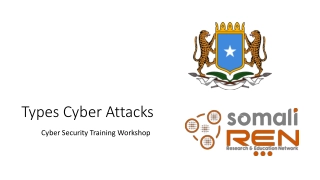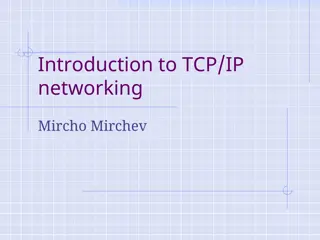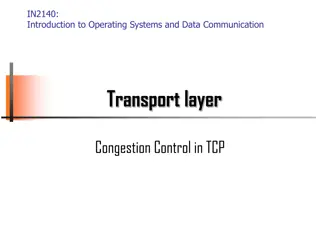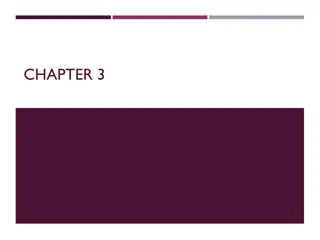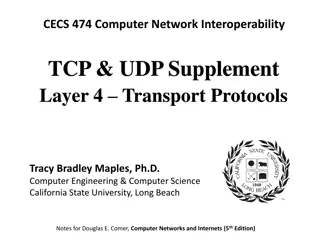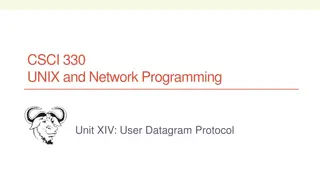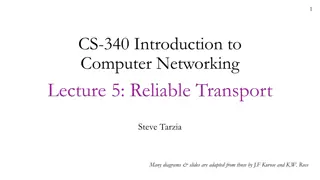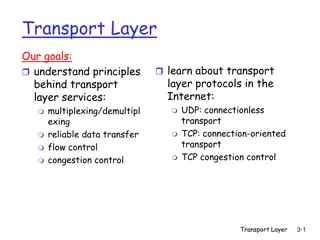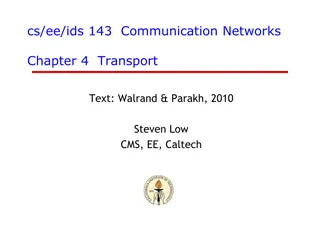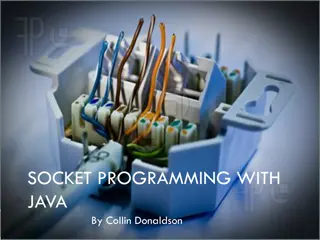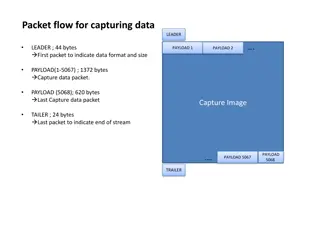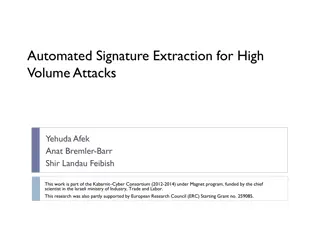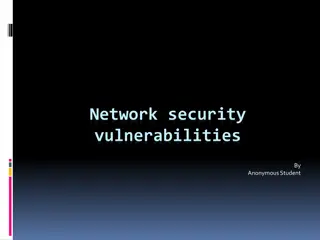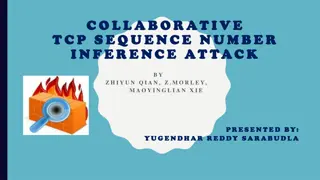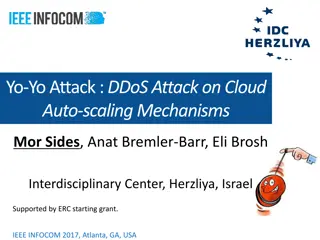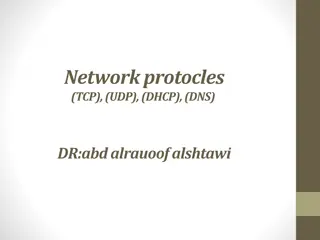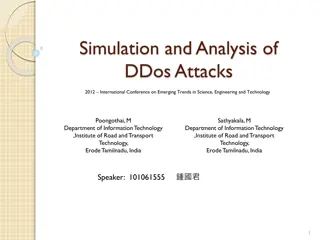The Internet: Layers, TCP, UDP, IP DDoS Reflection Attacks
Delve into the intricate layers of the Internet, exploring TCP, UDP, IP protocols, DDoS attacks, and more. Discover the infrastructure, data formats, routing mechanisms, and IP addressing intricacies that underpin this vast network.
Download Presentation

Please find below an Image/Link to download the presentation.
The content on the website is provided AS IS for your information and personal use only. It may not be sold, licensed, or shared on other websites without obtaining consent from the author.If you encounter any issues during the download, it is possible that the publisher has removed the file from their server.
You are allowed to download the files provided on this website for personal or commercial use, subject to the condition that they are used lawfully. All files are the property of their respective owners.
The content on the website is provided AS IS for your information and personal use only. It may not be sold, licensed, or shared on other websites without obtaining consent from the author.
E N D
Presentation Transcript
The Internet! Layers, TCP, UDP, IP DDoS Reflection Attacks IPSEC, ARP Sharon Goldberg CS558 Boston University Spring 2015 Most slides and images borrowed from others.
Internet Infrastructure ISP ISP ISP Local and interdomain routing TCP/IP for routing and messaging BGP for routing announcements Domain Name System Find IP address from symbolic name (www.cs.stanford.edu) Based on slides from CS155 at Stanford
TCP Protocol Stack Application protocol Application Application TCP protocol Port # Transport Transport IP protocol IP protocol IP addresses IP Network Network Network Access Data Link Data Link Link Link MAC address Based on slides from CS155 at Stanford
Data Formats TCP Header Application message - data message Application segment Transport (TCP, UDP) TCP data TCP data TCP data packet Network (IP) IP TCP data frame Link Layer ETH IP TCP data ETF IP Header Link (Ethernet) Header Link (Ethernet) Trailer Based on slides from CS155 at Stanford
Source: https://devcentral.f5.com/articles/application-is-more-than-header-deep
IP Prefixes & Addresses 204.16.254.0/24 is 204 16 254 * 0 1 1 0 1 0 0 0 0 0 0 0 1 0 0 0 1 1 1 1 1 1 1 0 1 8 16 24 32
Based on slides from CS155 at Stanford IP Routing Meg Office gateway Packet Source Destination 121.42.33.12 132.14.11.51 Tom 121.42.33.12 132.14.11.1 ISP 121.42.33.1 132.14.11.51 ROUTING TABLE Destination Prefix Next Hop IP 132.14.0.0/16 123.14.11.11 132.0.0.0/8 13.23.45.55 Typical route uses several hops IP: no ordering/delivery guarantees, connectionless, Best effort
Based on slides from CS155 at Stanford IP Protocol Functions (Summary) Routing IP host knows location of router (gateway) IP gateway must know route to other networks Fragmentation and reassembly If max-packet-size less than the user-data-size Error reporting ICMP packet to source if packet is dropped TTL field: decremented after every hop Packet dropped f TTL=0. Prevents infinite loops.
http://t3.gstatic.com/images?q=tbn:ANd9GcSfZSN2yERePIKILoDlxc0zrdOrMoecHEGRydOppGZgllPM25TNhttp://t3.gstatic.com/images?q=tbn:ANd9GcSfZSN2yERePIKILoDlxc0zrdOrMoecHEGRydOppGZgllPM25TN NATS
Based on slides from CS155 at Stanford UDP User Datagram Protocol (protocol=17) Unreliable transport on top of IP: No acks or congenstion control Used for VoIP, video, NTP (network time protocol) anything else where latency matters more than reliability
Based on slides from CS155 at Stanford Problem: no src IP authentication Client is trusted to embed correct source IP Easy to override using raw sockets Libnet: a library for formatting raw packets with arbitrary IP headers Anyone who owns their machine can send packets with arbitrary source IP response will be sent back to forged source IP Implications: (solutions in DDoS lecture) Anonymous DoS attacks; Anonymous infection attacks (e.g. slammer worm)
UDP DoS Reflection & Amplification Attack Using protocols over UDP: like NTP, DNS etc Public DNS Server 8.8.8.8 Huge response! DNS response Tom Source IP Dest IP 8.8.8.8 132.14.11.51 Short query Evillll Meg DNS Query DNS Data 132.14.11.51 Source IP Dest IP 132.14.11.51 8.8.8.8 Tom gets hit by too many packets 121.42.33.12
Based on slides from CS155 at Stanford TCP Transmission Control Protocol Connection-oriented, preserves order Sender Break data into packets Attach packet numbers Receiver Acknowledge receipt; lost packets are resent Reassemble packets in correct order Book 1 19 5 1 1 Mail each page Reassemble book
Source: https://devcentral.f5.com/articles/application-is-more-than-header-deep
Based on slides from CS155 at Stanford Review: TCP Handshake C S SNC randC ANC 0 SYN: Listening SNS randS ANS SNC Store SNC , SNS SYN/ACK: Wait SN SNC+1 AN SNS ACK: Established Received packets with SN too far out of window are dropped
Based on slides from CS155 at Stanford Basic Security Problems 1. Network packets pass by untrusted hosts Eavesdropping, packet sniffing Especially easy when attacker controls a machine close to victim 2. TCP state can be easy to guess Enables spoofing and session hijacking Depending on how sequence number is chosen 3. Denial of Service (DoS) vulnerabilities Syn connection state attacks
Based on slides from CS155 at Stanford 1. Packet Sniffing Promiscuous NIC reads all packets Read all unencrypted data (e.g., wireshark ) ftp, telnet (and POP, IMAP) may send passwords in clear Eve Network Alice Bob Prevention: Encryption (next lecture: IPSEC)
Based on slides from CS155 at Stanford 2. TCP Connection Spoofing Why random initial sequence numbers? (SNC , SNS ) Suppose init. sequence numbers are predictable Attacker can create TCP session on behalf of forged source IP TCP SYN srcIP=victim SYN/ACK dstIP=victim SN=server SNS Victim ACK Server srcIP=victim AN=predicted SNS attacker server thinks command is from victim IP addr command
Based on slides from CS155 at Stanford Example DoS vulnerability [Watson 04] Suppose attacker can guess seq. number for an existing connection: Attacker can send Reset packet to close connection. Results in DoS. Naively, success prob. is 1/232 (32-bit seq. # s). Most systems allow for a large window of acceptable seq. # s Much higher success probability. Attack is most effective against long lived connections, e.g. BGP
Based on slides from CS155 at Stanford Random initial TCP SNs Unpredictable SNs prevent basic packet injection but attacker can inject packets after eavesdropping to obtain current SN Most TCP stacks now generate random SNs Random generator should be unpredictable GPR 06: Linux RNG for generating SNs is predictable Attacker repeatedly connects to server Obtains sequence of SNs Can predict next SN Attacker can now do TCP spoofing (create TCP session with forged source IP)
Securing the IP/TCP stack HTTP FTP SMTP HTTP FTP SMTP SSL/TLS TCP TCP IP/IPSEC IP At the Network Level At the Transport Level S/MIME PGP SET Kerberos SMTP HTTP UDP TCP IP At the Application Level
Note: ToS leaks info. Source and dest address are not authenticated (vulnerable to IP address spoofing) between the tunnels. (DoS attacks too?) Source and dest address INSIDE the tunnel is protected. ESP Tunnel mode (From Steve Friedl)
ESP without authentication (From Steve Friedl) BAD IDEA!!!!!!!!!!!! Now we can encrypt, or encrypt and authenticate The padding allows us to reduce traffic analysis attacks, but people almost never use it.
AH Tunnel mode (From Steve Friedl) Authenticated connection for VPN Packet encapsulated, source and dest address protected Can t work with NATs
AH Transport mode (From Steve Friedl) Authenticated connection between two hosts (HMAC!!) Doesn t work with NAT (network address translation)
Note: ToS leaks info. P0 Source and dest address are not authenticated (vulnerable to IP address spoofing!) P1 P2 ESP Transport mode (From Steve Friedl)
AH Anti-replay Service in Ipsec From Stallings 5th edition window size W (default is 64) N: highest seq. number for a valid paket recevied so far If a received packet falls in the window if authenticated and unmarked, mark it if marked, then replay! If a received packet is > N if authenticated, advance the window so that this packet is at the rightmost edge and mark it If a received packet is <= N-W packet is discarded
Other considerations Traffic analysis : packet lengths, Timing Source and destination addresses ToS fields Dealing with NATs Replay attacks Key management!!!
TLS packet format As opposed to unsecured HTTP URLs which begin with "http://" and use port 80 by default, secure HTTPS URLs begin with "https://" and use port 443 by default.
IPSEC VS TLS? People are still talking about this! http://www.metzdowd.com/pipermail/crypto graphy/2014-April/020674.html [Cryptography] IPsec is worse than unusable (Re: TLS/DTLS Use Cases) Nico Williams nico at cryptonector.com Wed Apr 2 11:59:52 EDT 2014 Previous message: [Cryptography] TLS/DTLS Use Cases Next message: [Cryptography] IPsec is worse than unusable (Re: TLS/DTLS Use Cases) Messages sorted by: [ date ] [ thread ] [ subject ] [ author ] On Tue, Apr 01, 2014 at 10:31:54PM -0400, Jerry Leichter wrote: > IPSec has many faults - so many as to render it unusable - but it did > get one thing right: To most code, an IPSec socket looks just like a > plain TCP socket. Anything that talks TCP can talk TCP "securely" > over IPSec with essentially no changes. ("Securely" in quotes because > it's a rather specialized notion of "securely".)
What is ARP? Address Resolution Protocol (ARP) is how network devices associate MAC addresses with IP Addresses so that devices on the local network can find each other. ARP is basically a form of networking roll call. ARP, a very simple protocol, consists of merely four basic message types: An ARP Request. Computer A asks the network, "Who has this IP address?" An ARP Reply. Computer B tells Computer A, "I have that IP. My MAC address is [whatever it is]." A Reverse ARP Request (RARP). Same concept as ARP Request, but Computer A asks, "Who has this MAC address?" A RARP Reply. Computer B tells Computer A, "I have that MAC. My IP address is [whatever it is] FROM: http://www.watchguard.com/infocenter/editorial/135324.asp
ARP poisoning What is the threat model for arp poisoning?
Great Cannon of China The GC is currently aimed only at specific destination IP addresses When we probed an IP address adjacent to the Baidu server (123.125.65.121), the GC ignored the requests completely, although the GFW acted on censorable requests to this host If the GC saw a request for certain Javascript files on one of these servers, it appeared to probabilistically take one of two actions: it passed the request onto Baidu s servers unmolested (roughly 98.25% of the time), or it dropped the request before it reached Baidu and instead sent a malicious script back to the requesting user (roughly 1.75% of the time). In this case, the requesting user is an individual outside China browsing a website making use of a Baidu infrastructure server (e.g., a website with ads served by Baidu s ad network). The malicious script enlisted the requesting user as an unwitting participant in the DDoS attack against GreatFire.org and GitHub.
Topics (Week of December 1, 2015) 1. Review IP address and routing tables 2. ARP and ARP spoofing 3. Spoofing source IP addresses 4. UDP, UDP Reflection attacks using source address spoofing (DNS, NTP) 5. TCP, Forging TCP connections, TCP sequence numbers, Censorship via TCP resets 6. TLS packet formats 7. Traffic analysis on IP and TLS packets 8. Censorship techniques 1. IP-based filtering 2. DNS & DNS based filtering 3. TCP-reset based filtering 4. Malicious MiTM packet injection & great cannon of china


